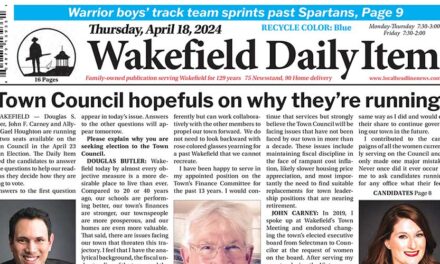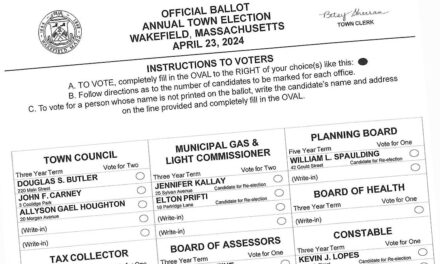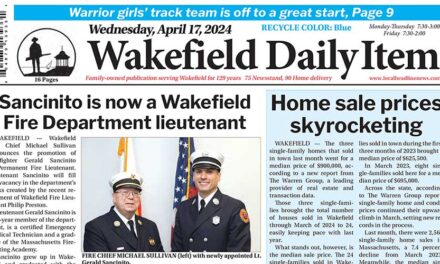Published in the October 26, 2015 edition.
By MARK SARDELLA
WAKEFIELD — It appears that Shelter Development can now move forward with its plans to construct a Brightview Senior Living facility on Crescent Street with 130 units of combined assisted living and independent living.
The period for appealing the Zoning Board of Appeal’s decision to approve the Special Permits allowing the project expired last Monday, Oct. 19 and no appeal was filed, according to the Town Clerk’s office. In addition, a Land Court case filed by opponents in connection to the project was dismissed on Oct 16.
“My client is very pleased that no appeal has been filed,” said attorney Brian McGrail, who has been representing Shelter Development in the local permitting process. “They are very excited to move forward with the project and become a great citizen of the town of Wakefield.”
Shelter plans to build the Brightview facility on properties it is purchasing from the Fraen Corporation, including 338 Main St. and 11, 15, 17, 19 and 21 Crescent St., all of which are within the Assisted Living Overlay District created by a Town Meeting vote in 2012. Those buildings will be razed to make way for the project. A property at 25 Crescent St. is not in the overlay district and will be landscaped open space on one side of the building.
Opponents cited many reasons why they believed the facility should not be built, including issues related to traffic, parking, sewage and drainage. But mainly those opposed to the project argued that a four-story, 130-unit facility was simply much too large for the site and the neighborhood.
After 10 months of hearings, the Zoning Board of Appeals approved the Special Permits related to the project on July 29, 2015. But the 20-day appeal period began when the ZBA’s written decision was filed with the Town Clerk on Sept. 28, 2015.
“I was happy to hear that the appeal period ended without an appeal being filed,” ZBA chairman David Hatfield said. “I look forward to the applicant starting the next phase of the project.”
Not everyone is pleased that the project can move forward.
“It’s too big for the location and far too intrusive for that neighborhood,” said Bronwyn Della-Volpe of Cyrus Street, a vocal opponent of the project. “I, along with others, have great concerns about the effects this project and its protracted construction phase will have on the town, residents and businesses in the area.” She insisted that the town “must have a comprehensive Plan that first protects its residents and neighborhoods, recognizes the inherent value of resident input and treasures its history.”
Patrick Bruno of Mackenzie Lane was another vocal opponent of the project.
“Through the participation of individual members of our family and all other interested Wakefield citizens, the Zoning Board of Appeals heard and considered all of the complex facets of the project, including the expected impact upon our community,” Bruno said. “After considerable reflection of the existing options involved, the Bruno family has determined that they will have no further involvement in any aspect of the development.”
Another opponent, Robert McLaughlin of Water Street, said his primary objection revolved around the demolition of the six older, residential homes on Crescent Street. One in particular, 17 Crescent St., had once been the home of Dr. John Hart. Hart is said to have been a Revolutionary War figure and an associate of Gen. George Washington. Locally, Hart served as town moderator, selectman, School Committee member and state representative.
“I can’t believe they’re going to tear the Hart House down and the town has no problem with it,” McLaughlin said. He called Brightview “a money-making machine for some out-of-state investors.” The project, he added, “will diminish the New England feel of our downtown.”
In January of 2015, Wakefield Historical Commission did declare a six-month demolition moratorium on the Hart House and another home, 19 Crescent St., believed to be the oldest original home on the street. At that meeting Shelter’s Director of Development Michael Glynn affirmed Shelter’s willingness to contribute funds up to $10,000 per house toward relocating the structures. McGrail added that if demolition does occur, Shelter would also commit to hiring an expert to document the homes and see what could be preserved that is of historic importance.
The history of Shelter/Brightview in Wakefield dates back to 2013 when they approached the town about building an assisted living facility on the site. The town offered to convey an adjacent town owned lot that would provide the needed square footage to expand the size of the facility if Shelter would also agree to include independent living units and build a parking garage with spaces for public use.
A Special Town Meeting on Feb. 6, 2014 approved the deal by the necessary two-thirds majority. However, a group of local citizens collected the more than 200 signatures needed to force a town-wide election on April 1, 2014. The land conveyance that was key to the garage proposal was defeated in that election.
On the night of the election, the anti-garage group submitted a petition signed by 11 voters to remove the land in question from the assisted living overlay district and effectively preclude the future building of any assisted living facility on the site.
But a second citizens’ petition signed by hundreds of voters in favor of the combined assisted living facility and parking garage sought to revisit the original proposal at the 2014 Annual Town Meeting.
The article to eliminate the Assisted Living Overlay District was defeated at Town Meeting, preserving options for a future proposal.
Those who favored the combined assisted living/garage proposal were also in the majority, with the final Town Meeting vote tallied at 459-377. But those who favored the garage came up 99 votes short of the two-thirds majority required to convey the town-owned land that was key to the garage proposal.
A new application was filed by Shelter on Sept. 9, 2014 for a 137-unit combined assisted living/independent living project. Hearings began on Oct. 8, 2014. Over the course of the ensuing 10 months of hearings, the project was reduced to the 130-unit proposal that was approved on July 29.




